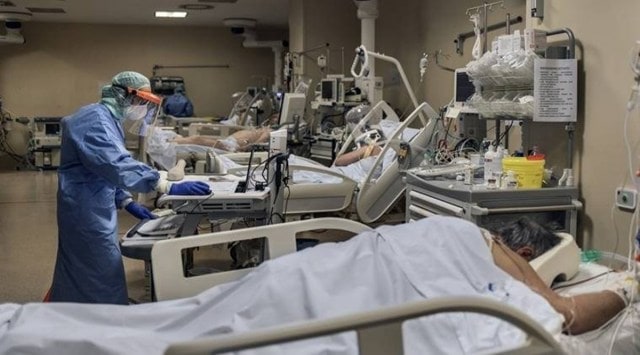- India
- International
Covid hospitals gasp as shortage of oxygen hits health facilities in Gujarat
Alarm bells first rang when nodal officer at Vadodara’s Gujarat Medical Education and Research Society-run (GMERS) Dr Shital Mistry, wrote to the state health and drug control departments about the crisis it had been facing since September 2.
 Smaller nursing homes and private hospitals continue to charge for bio-medical waste, personal protective equipment and oxygen for Covid-19 treatment, making healthcare unaffordable despite a slew of measures to cap prices by the state government. (FIle photo)
Smaller nursing homes and private hospitals continue to charge for bio-medical waste, personal protective equipment and oxygen for Covid-19 treatment, making healthcare unaffordable despite a slew of measures to cap prices by the state government. (FIle photo)The Gujarat government notification on Thursday regularise the supply and circulation of medical oxygen from production units across the state came after a scare faced by Covid-19 hospitals in Ahmedabad and Vadodara over the last fortnight over severe shortage of oxygen.
Alarm bells first rang when nodal officer at Vadodara’s Gujarat Medical Education and Research Society-run (GMERS), Gotri, Dr Shital Mistry, wrote letters to the state health and drug control departments about the crisis it had been facing since September 2.
On Thursday, Parekh Hospital in Ahmedabad, which has a Memorandum of Understanding (MoU) with Ahmedabad Municipal Corporation (AMC) for treating
Covid-19 patients, had to transfer seven patients to the government-run civil hospital at Sola, on the city’s outskirts when it ran out of oxygen. The hospital has a private tie-up for medical oxygen supply with one Cosmic Agency which was unable to meet the demand. An AMC health official also reiterated that similar shortages have been reported from several private hospitals in the past few days.
Additional Director of Medical Education Dr Raghavendra Dixit told The Indian Express that Covid-19 has raised the demand for oxygen by as much as five times in the state. Gujarat has four oxygen manufacturing giants – Lynde India, Inox India, Air Liquid and Sriram Oxygen.

Mistry’s letter had suggested that oxygen for industrial usage be capped and diverted for medical use, as was done in Maharashtra. “Until now, 80% Liquid Oxygen (Lox) was given for industrial use, while 20% for medical use because until Covid-19 and then its peak, the Lox requirement for medical purposes was barely 15%. The decision of the government to allocate 50% for medical use will now help,” Mistry told this paper.
Vadodara’s Officer on Special Duty for Covid-19, Vinod Rao, appointed J P Patel, Assistant Commissioner in the FDA, as nodal officer for oxygen supply in Vadodara on Tuesday, citing the shortage could have resulted in “tragedy of human lives”. Now Gotri hospital is installing a Lox tank with a capacity of 13,000 litres.
Hospitals say that vendors of oxygen, who charged Rs 35-36 per cubic metre for Lox and Rs 13 per cubic metre for oxygen cylinder, have increased the prices to about Rs 45 per cubic metre for Lox and Rs 17-18 cubic metres for oxygen cylinders.
“The requirement has definitely increased by more than double. Especially in case of High Flow Nasal Cannula (HFNC), the requirement of oxygen per machine is quite high. The companies are not in a position to supply Lox at the same rate because they say they have to procure oxygen from other states at a higher rate. So prices that were frozen before the pandemic are not in place anymore. Oxygen rates have definitely gone up by at least 10%. Despite the fact, due to the increasing (Covid-19) centres pan-India, there is shortage not just of the Lox but also of cylinders – like the Dura and jumbo cylinders which are manufactured elsewhere. We faced some issue last week with procuring liquid oxygen but we managed to get cylinders from our second vendor,” says Indrajit Singh, CEO of Tricolour hospital in Vadodara, which is treating 45 Covid-19 patients.
Health commissioner Jaiprakash Shivahare claimed that “all hospitals have piped oxygen supply in the state.” However, in some districts the issue is of transporting the said medical oxygen from outside which may take up to six hours or more. Like Amreli which has to account for six hours of transportation of O2 cylinders from either Surendranagar or Rajkot, where it is manufactured.
Piped oxygen supply can be of pressurised oxygen gas, supplied at the hospital-level by a tanker or by a series of jumbo cylinders.
“One tanker can be equivalent in capacity to 110 jumbo cylinders,” said a government officer. Bigger hospitals like Ahmedabad Civil hospital with 1,000-plus bed capacity prefer to store oxygen in cryogenic tanks, this one having 20 kilolitre Lox capacity.
According to the Gujarat Medical Services Corporation Limited (GMSCL), the state government’s arm for procurement and supply of drugs for government hospitals, the body has rate contract agreements signed with two supplier companies – Inox, which caters to the north Gujarat districts, and Lynde, which supplies to Saurashtra districts. Managing director Navnath Gavhane said GMSCL has a two-year contract with Inox and Lynde and demand estimates were assessed on the basis of indents raised by government hospitals.
A government official privy to the process explained that GMSCL’s role is only limited to fixing of rates, which factors in transportation costs as well via a tendering process and empanelling suppliers. At the local level, hospitals coordinate with the said suppliers and in case of emergency, as was seen during the lockdown period, local governments had struck contracts with suppliers to cater to their need.
A supplier to Covid-19 hospitals in Central Gujarat admitted that the pressure had led to industrial oxygen being diverted to hospitals even before the notification regularising it. “Medical Oxygen has become such a precious commodity that we are considering seeking police protection for tankers now,” the supplier said.
Another vendor, who has been working in South Gujarat as well as some hospitals in Vadodara and Anand, said, “…The shortage is because there are some influential companies in Saurashtra who have high purity oxygen available for industrial use. If they are directed to supply oxygen for medical use and the Drug Controller General of India issues licences to more companies in Gujarat to manufacture Lox, it will ensure that there is no shortage.”
An executive of a top oxygen manufacturing company in Gujarat told this newspaper, “Oxygen companies have been asked to keep complete records of production, sale as well as rates, which are analysed from time to time by the Central Drugs Standard Control Organisation (CDSCO) since May this year due to the Covid-19 outbreak. There are only 26 manufacturers of medical oxygen in the country with most of them located in Punjab, Maharashtra, Gujarat and Karnataka. The companies also supply oxygen to other states… The shortage is real but it can be managed if industrial oxygen is prudently used.”
Rajkot’s oxygen demand also went up as cases surged of late. “As a number of Covid hospitals have come in the city over the past one month or so, oxygen demand has tripled. Before the pandemic began, I used to supply 30 cylinders each having capacity of seven cubic metres every day. These days, I am supplying 60 to 70 cylinders…,” said Darshan Lakhani, manager of Jaydeep Oxygen Private Limited, a private firm which has a plant in Shapar-Veraval on the outskirts of the city.
Lakhani said that their plant manufactures medical oxygen in gas form and also provides services of supplying liquid oxygen by sourcing it from third parties. AIMS Oxygen Private Limited of Vadodara and Hingorani Air Products Private Limited of Rajkot are also leading suppliers of medical oxygen in Rajkot.
In Surat, SMIMER and government-run New Civil Hospitals fulfil their oxygen demands from Inox, and private hospitals get it from Lynde and others. Deputy Health commissioner of SMC, Dr Ashish Naik said, “We have not faced any shortage of liquid oxygen, even during the peak time.”
The daily consumption of liquid oxygen in Surat city was around 27 metric tonnes per day in both SMIMER and NCH hospitals, while at present the daily consumption is 12 metric tonnes per day, said officials of Surat health department.
With inputs from Kamaal Saiyed in Surat
Must Read
Apr 23: Latest News
- 01
- 02
- 03
- 04
- 05






































